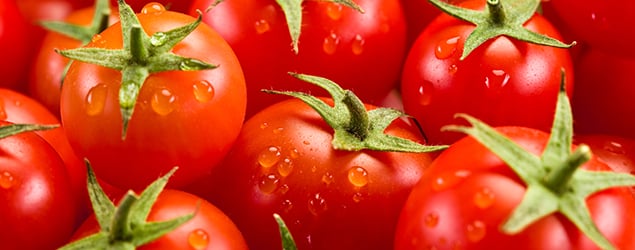Genetically Modified Monday (#GMOMonday)

On the steps of the Salem, New Jersey, courthouse in 1830, legend has it that a daredevil named Robert Johnson elicited gasps from the crowd when he announced his next trick. Some remarked that he would be dead before morning; others simply watched in horror as he held aloft a small red object.
His stunt? He was about to eat a raw tomato.
Today this stunt would be laughable, but there’s a reason why it would have excited the crowd back then. At that time, people understood that wild plants are frequently dangerous to those who consume them—they are chock full of toxins and allergens that pose a real threat.
People probably still stand on the steps of the New Jersey courthouse and enjoy raw tomatoes, perhaps in a salad. But everything in that salad would be practically unrecognizable to our stone-age counterparts.
The foods we enjoy today are the product of thousands of years of human-influenced changes. Thankfully, they have been radically altered from their natural states; but the journey is not over for them. Up until recently, these improvements were done using the painstaking and relatively imprecise method of selective breeding, grafting and crossbreeding. Now scientists have found ways to improve plant and animal cells on the genetic level. They have searched for and found genes responsible for both desirable and undesirable traits and then unlocked the DNA—adding, eliminating or turning down the expression of these genes.
In researching these genetically modified plants and animals, I was struck by the wide variety of ways scientists have engineered food to solve health problems, improve taste, increase nutrition, alleviate allergies, on and on. From serious to fun, these foods have potential worth talking about.
So, I am excited to unveil “Genetically Modified Monday.” Each Monday, I will write about one of the new genetic improvements to the food we eat. You can chime into the discussion by tweeting, using the hashtag #GMOMonday (“GMO” stands for “genetically modified organism”). What are some of the improved foods you are thinking about or enjoying today?
Today, I’m thinking about golden rice.
Vitamin A deficiency isn’t something we worry about too much in the United States, thanks to plentiful nutritious food. But vitamin A deficiency is a big problem in poor nations. The World Health Organization estimates that between a quarter and a half million children go blind each year for want of vitamin A. Even more unfortunate is that about half of those children will be dead within twelve months.
Many of those children have access to rice, but rice on its own doesn’t supply all of the necessary nutrients for a long and healthy life—one crucial deficiency in rice is a lack of beta carotene. When we eat beta carotene, our bodies convert it into the vitamin A we need. Beta carotene is found naturally in carrots and some other fruits and vegetables, but not in rice. Even though all the required genes to produce beta-carotene are present in rice, some of them are turned off during development of the rice grain itself.
The inventors of golden rice, Ingo Potrykus and Peter Beyer, discovered first that the genetic pathway needed was already inside each grain of rice. Then they figured out how to “turn on” this pathway with the addition of a single borrowed daffodil gene.
The result was golden rice. It is the beta carotene that gives it its characteristic golden color. It can cheaply combat blindness and malnutrition in children in the poorest of nations. Simply plant and eat.
A final note: Curiously, golden rice has sparked major controversy. Do you have concerns about the safety of genetically modified foods? I’ll be writing about the supposed dangers soon. Meanwhile, enjoy #GMOMonday.
(By the way, not to worry: Robert Johnson survived after eating that raw tomato.)
Update: This post’s title and text were updated to change the Twitter hashtag to “GMOMonday” and to clarify that “GMO” stands for “genetically modified organism.”



